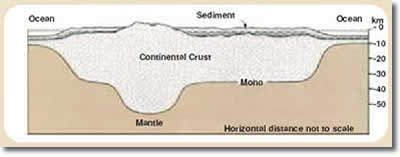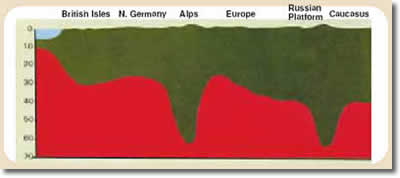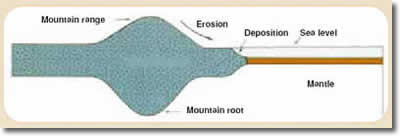 |
| Quran | Audio | Video | Miracles | Articles | Manuscripts | Webmasters | Contact |
 |
THE FUNCTION OF MOUNTAINS The Qur'an draws attention to a very important geological function of mountains:
The verse states that mountains perform the function of preventing shocks in the Earth. This fact was not known by anyone at the time the Qur'an was revealed. It was, in fact, brought to light only recently, as a result of the findings of modern geological research. Formerly, it was thought that mountains were merely protrusions rising above the surface of the Earth. However, scientists realised that this was not actually the case, and that those parts known as the mountain root extended down as far as 10-15 times their own height. With these features, mountains play a similar role to a nail or peg firmly holding down a tent. For example, Mount Everest, the summit of which stands approximately 9 km above the surface of the Earth, has a root deeper than 125 km.24
Mountains emerge as a result of the movements and collisions of massive plates forming the Earth's crust. When two plates collide, the stronger one slides under the other, the one on the top bends and forms heights and mountains. The layer beneath proceeds under the ground and makes a deep extension downward. Consequently, as stated earlier, mountains have a portion stretching downwards, as large as their visible parts on the Earth. In a scientific text, the structure of mountains is described as follows:
Professor Siaveda, a world-renowned underwater geologist, made the following comment in reference to the way that mountains have root-like stalks attaching them to the surface:
Furthermore, a book titled Earth, by Dr. Frank Press, former president of the U.S. National Academy of Sciences, which is still used as a text book in a great many universities, states that mountains are like stakes, and are buried deep under the surface of the Earth.27 In other verses, this role of the mountains is pointed out by a comparison with "pegs":
In another verse it is revealed that Allah "made the mountains firm." (Qur'an, 79:32) The word "arsaha" in this verse means "was made rooted, was fixed, was nailed to the earth." Similarly, mountains extend to the surface layer joining lines on and below the surface, and nail these together. By fixing the Earth's crust they prevent any sliding over the magma layer or amongst the layers themselves. In short, mountains can be compared to nails holding strips of wood together. The fixing effect of mountains is known as isostasy in scientific literature. Isostasy is the state of equilibrium between the upward force created by the mantle layer and the downward force created by the Earth's crust. As mountains lose mass due to erosion, soil loss or melting of glaciers, they can gain mass from the formation of glaciers, volcanic explosions or soil formation. Therefore, as mountains grow lighter they are pressed upwards by the raising force implemented by the liquids. Alternatively, as they grow heavier they are pressed into the mantle by the force of gravity. Equilibrium between these two forces is established by isostasy. This balancing property of mountains is described in these terms in a scientific source:
Today, we know that the rocky external layer of the Earth's surface is riven by deep faults and split into plates swimming above the molten lava. Since the Earth revolves very quickly around its own axis, were it not for the fixing effect of the mountains, these plaques would shift. In such an event, soil would not collect on the Earth's surface, water would not accumulate in the soil, no plants could grow, and no roads or houses could be built. In short, life on Earth would be impossible. Through the mercy of Allah, however, mountains act like nails, and to a large extent, prevent movement in the Earth's surface.
This vital role of mountains, which has been discovered by modern geological and seismic research, was revealed in the Qur'an centuries ago as an example of the supreme wisdom in Allah's creation.
24. www.wamy.co.uk/announcements3.html,
from an address by Prof. Zighloul Raghib El-Naggar. Source: www.miraclesofthequran.com [1/1/2009] |
|
|


